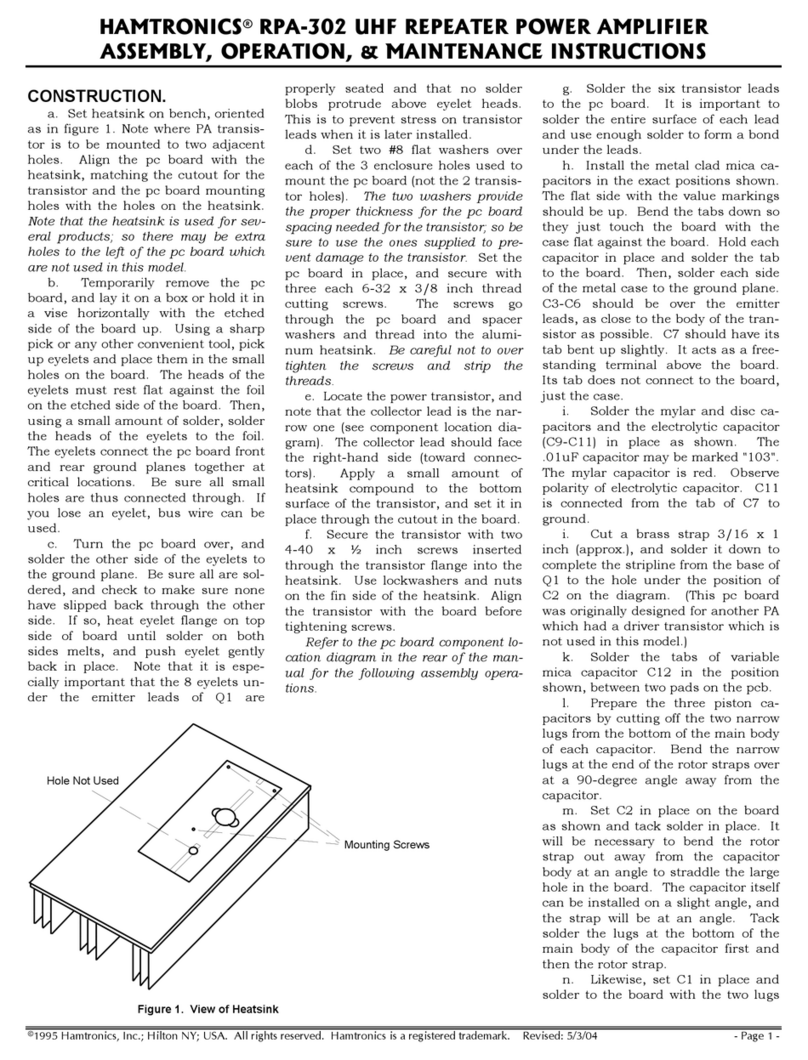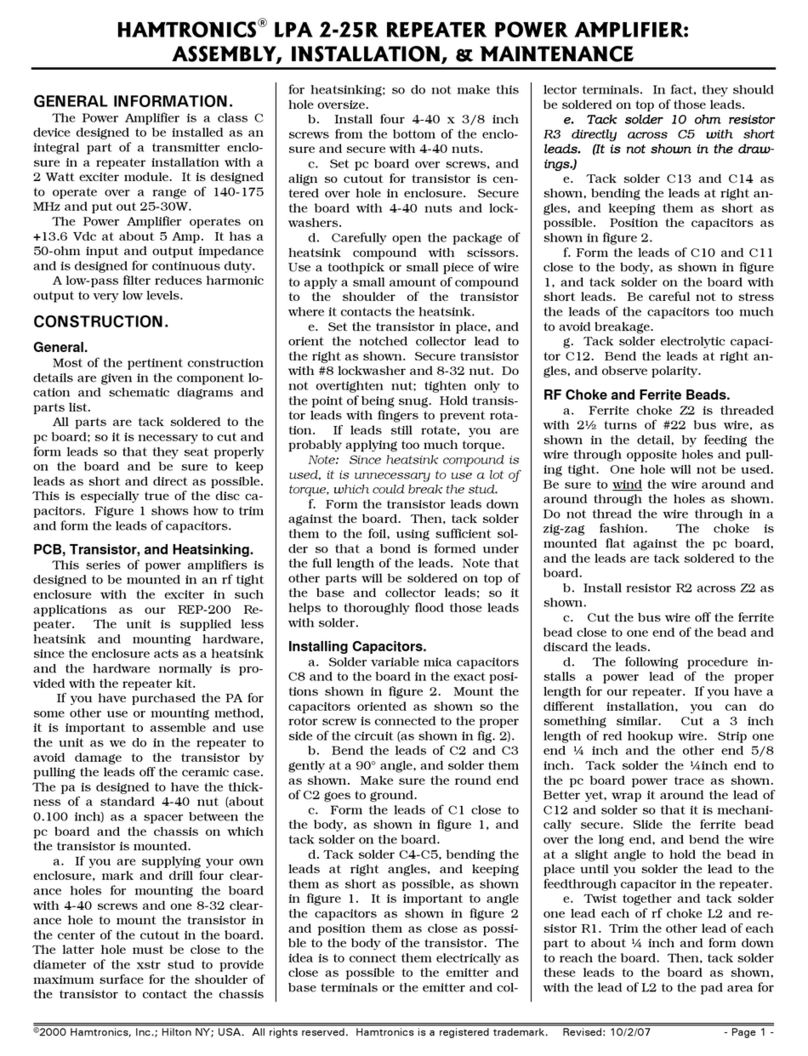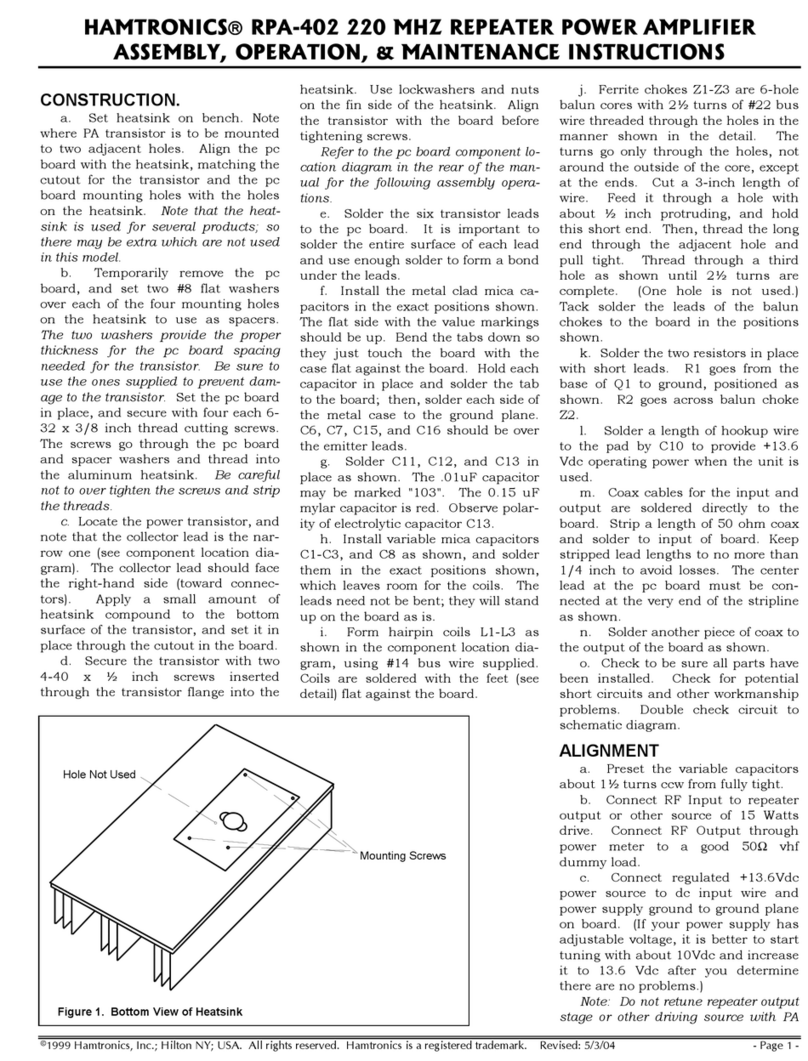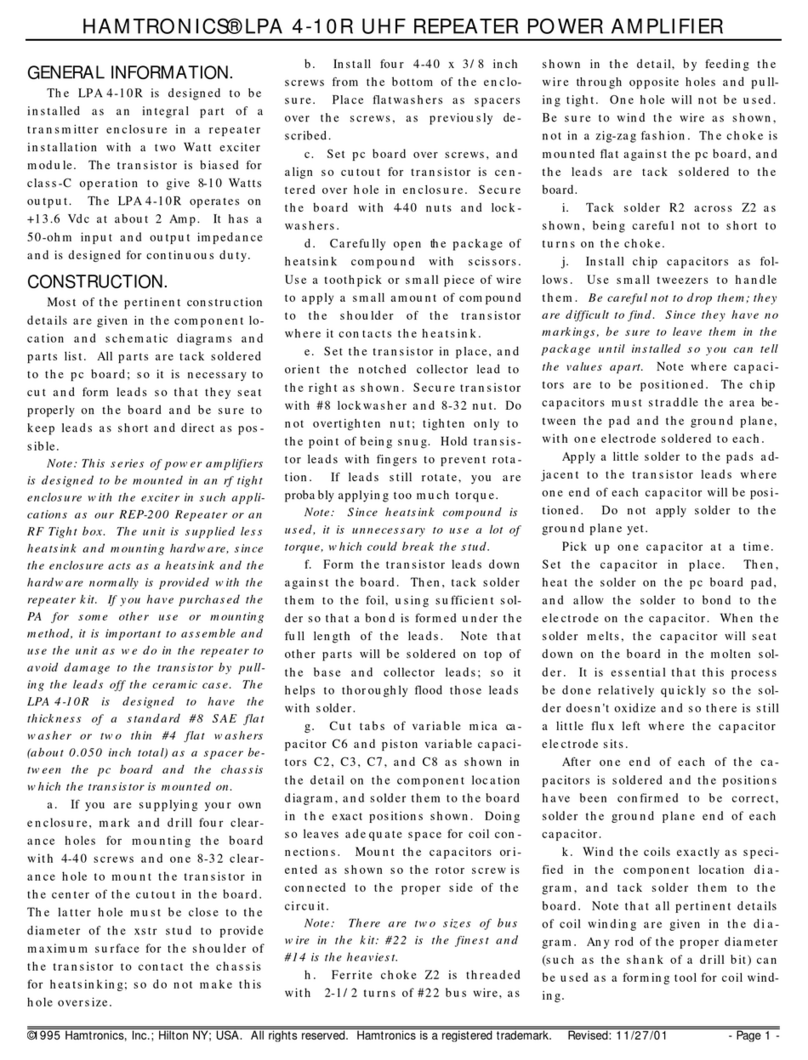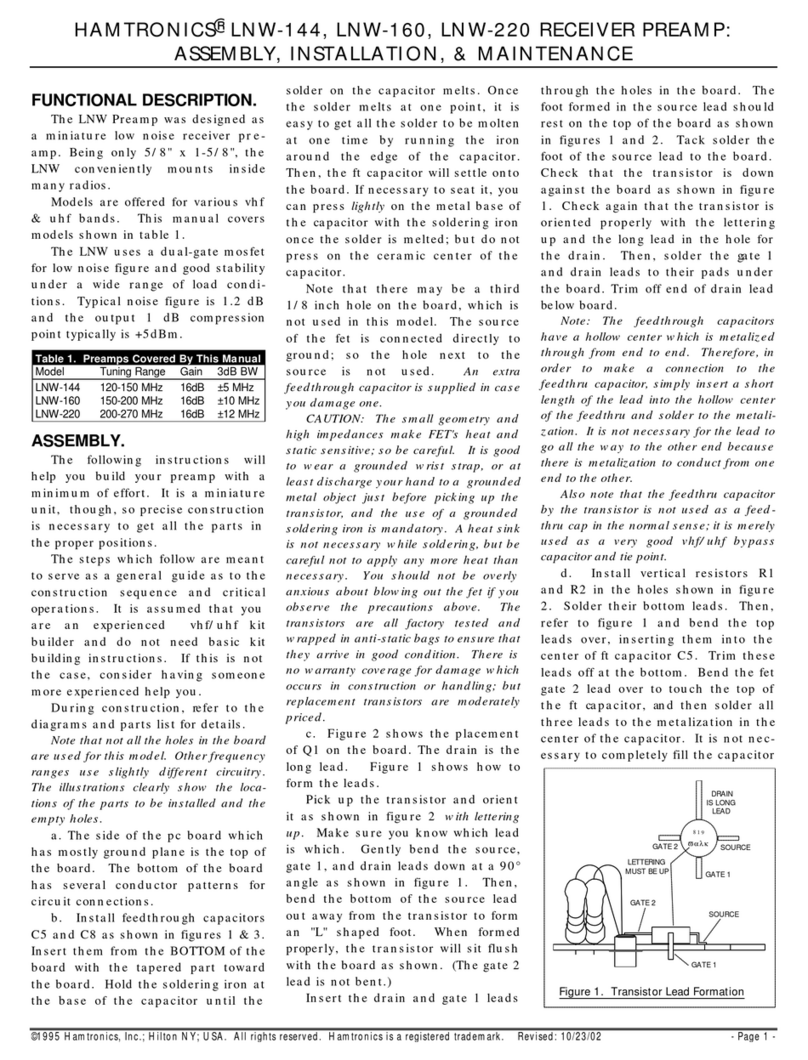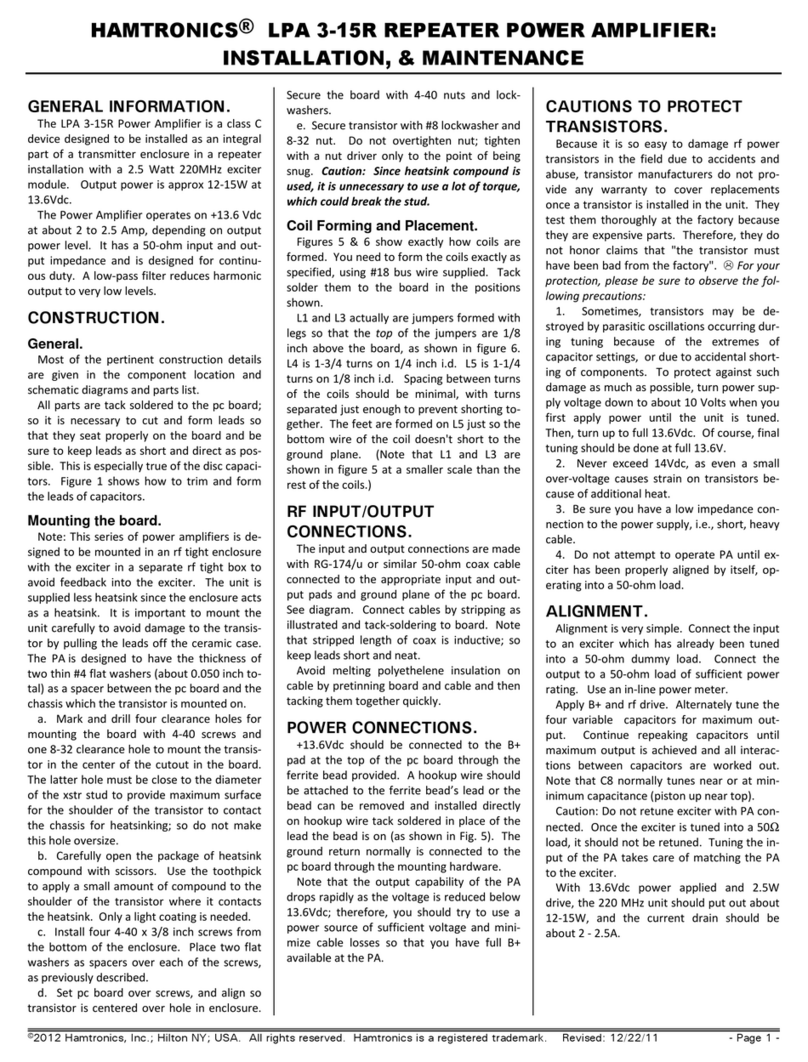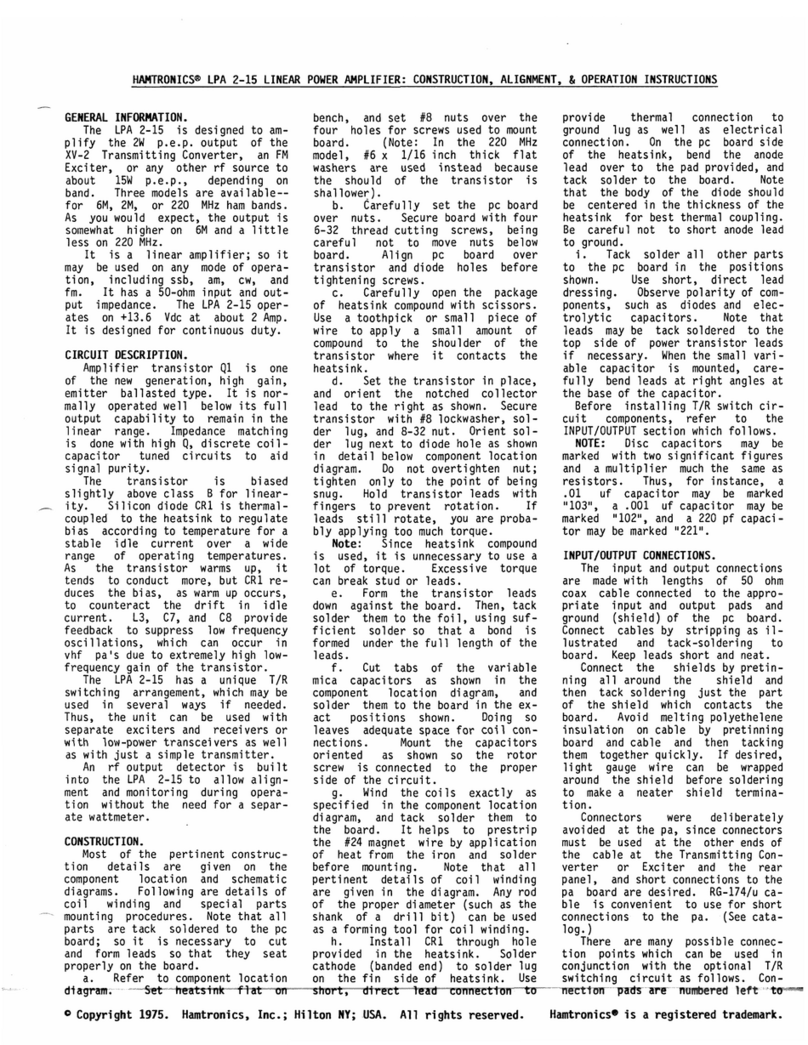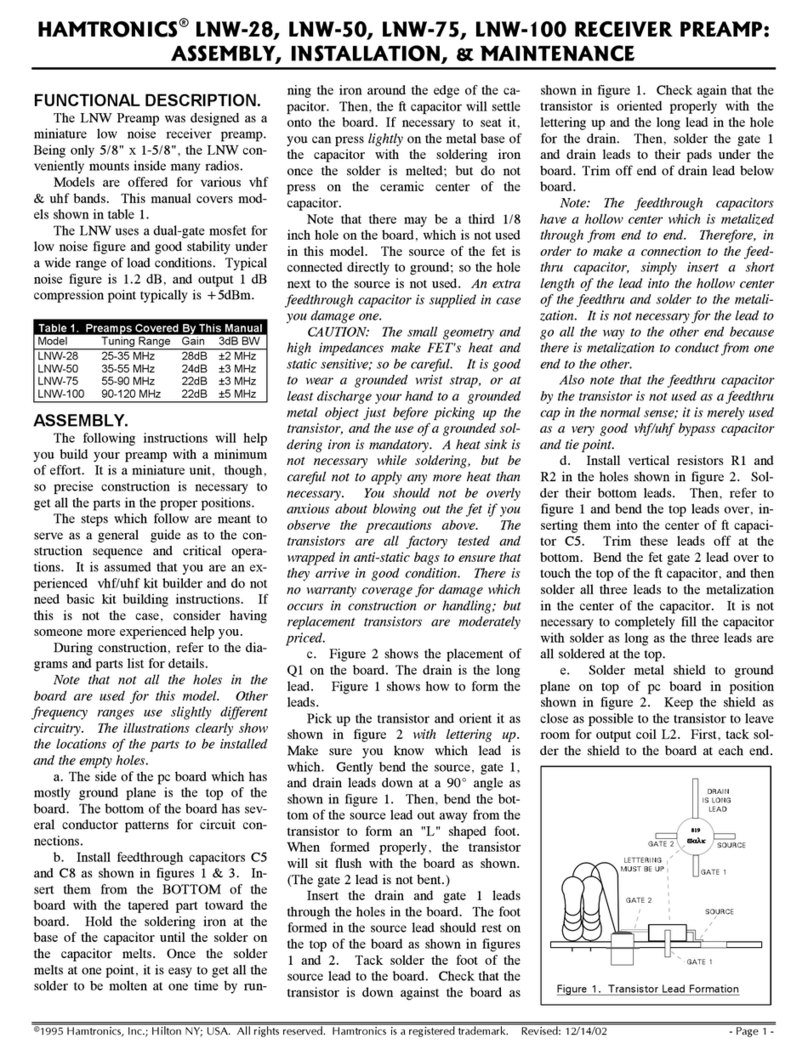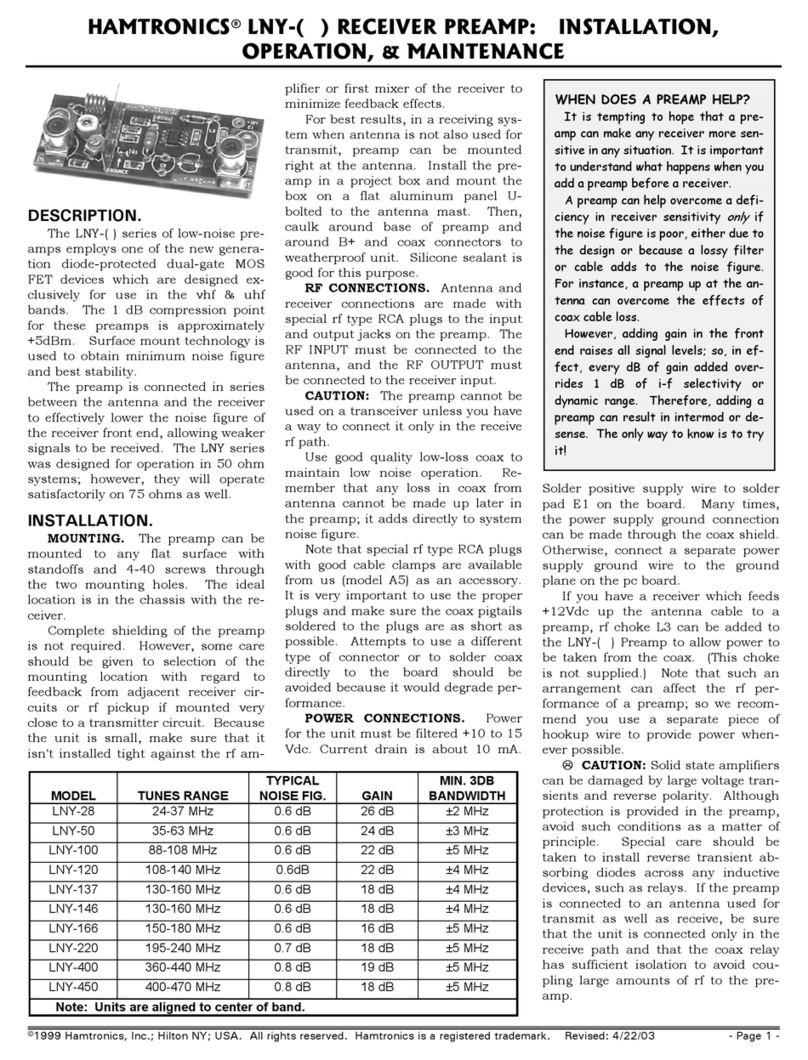
©1999 Hamtronics, Inc.; Hilton NY; USA. All ri
hts reserved. Hamtronics is a re
istered trademark. Revised: 12/11/02 - Pa
e 2 -
RF Choke, Ferrite Beads, and Re-
sistors.
a. Ferrite choke Z2 is threaded
with 2½ turns of #22 bus wire, as
shown in the detail, by feeding the
wire through opposite holes and pull-
ing tight. One hole will not be used.
Be sure to wind the wire around and
around through the holes as shown.
Do not thread the wire through in a
zig-zag fashion. The choke is
mounted flat against the pc board,
and the leads are tack soldered to the
board.
b. Install resistor R2 across Z2 as
shown.
c. Cut the bus wire off the ferrite
bead close to one end of the bead and
discard the leads.
d. The following procedure in-
stalls a power lead of the proper
length for our repeater. If you have a
different installation, you can do
something similar. Cut a 3 inch
length of red hookup wire. Strip one
end ¼ inch and the other end 5/8
inch. Tack solder the ¼inch end to
the pc board power trace as shown.
Be careful to apply fresh solder over
the wire so you don't get a cold solder
joint from simply reheating solder al-
ready on the trace. Slide the ferrite
bead over the long end, and bend the
wire at a slight angle to hold the bead
in place until you solder the lead to
the feedthrough capacitor in the re-
peater.
e. Twist together and tack solder
one lead each of rf choke L2 and re-
sistor R1. Trim the other lead of each
part to about ¼ inch and form down
to reach the board. Then, tack solder
these leads to the board as shown,
with the lead of L2 to the pad area for
the base of the transistor and the
lead of R1 to the ground plane.
f. For 220 MHz, install R3 and
R4 with very short leads exactly as
shown. Tack solder to traces and
ground plane.
Coil Forming and Placement.
Figures 2 & 3 and 5 & 6 show ex-
actly how coils are formed for the 144
and 220 MHz versions of the PA, re-
spectively. If you have the 6 meter
version, separate drawings are pro-
vided for that unit.
You need to form the coils exactly
as specified, using #18 bus wire sup-
plied. Tack solder them to the board
in the positions shown.
Any rod of the proper diameter
(such as the shank of a drill bit) can
be used as a forming tool for coil
winding. It is important that they not
only be wound the proper inside di-
ameter but that the leads be the
proper length. Any extra lead length
adds to the inductance and will affect
performance. You don't need to be
super precise, but do form them to
resemble the detailed drawings as
closely as you can.
Remember that the finished coils
should fit on the pc traces as shown;
so that will help you check that you
formed the coils properly.
For 144 MHz, the coils are all ei-
ther 1/8 or 1/4 inch inside diameter.
Spacing between turns of the coils
should be minimal, with turns sepa-
rated just enough to prevent shorting
together.
L1 is 1/8 inch i.d. and 1-1/4
turns. The feet are formed just so the
bottom wire of the coil doesn't short
to the ground plane. The feet should
be only about 1/16 inch high. The
other three coils are 1/4 inch i.d. L3
is 1-1/4 turns. L4 is 3-3/4 turns.
L5 is 1-3/4 turns.
For 220 MHz, L1 and L3 actually
are jumpers formed with legs so that
the top of the jumpers are 1/8 inch
above the board, as shown in figure
6. L4 is 1-3/4 turns on 1/4 inch i.d.
L5 is 1-1/4 turns on 1/8 inch i.d.
Spacing between turns of the coils
should be minimal, with turns sepa-
rated just enough to prevent shorting
together. The feet are formed on L5
just so the bottom wire of the coil
doesn't short to the ground plane.
(Note that L1 and L3 are shown in
figure 5 at a smaller scale than the
rest of the coils.)
Inspection.
This completes assembly. Check
to be sure all parts are installed ac-
cording to parts list. Look for any
short circuits or bad solder joints. RF
power transistors are expensive to re-
place; so now is the time to find prob-
lems, before power is applied.
RF INPUT/OUTPUT
CONNECTIONS.
The input and output connections
are made with RG-174/u 50-ohm
coax cable connected to the appro-
priate input and output pads and
ground plane of the pc board.
The following lengths assume that
PA will be installed in REP-200 Re-
peater. The input cable should be 5½
inches long and the output cable
should be 3 inches long, measured
before stripping the ends.
Connect cables by stripping and
tack-soldering to board as illustrated.
Note that stripped length of coax is
inductive; so keep pigtail leads as
short as possible.
Connect the shields by pretinning
the shield and then tack soldering
the end which contacts the board.
Avoid melting polyethylene insulation
on cable by pretinning board and ca-
ble and then tacking them together
quickly.
POWER CONNECTIONS.
+13.6Vdc should be connected to
the B+ pad at the top of the pc board.
When installed in an REP-200 Re-
peater, a hookup wire should be at-
tached to the B+ pad as shown, using
a ferrite bead on the far end, which
attaches to the feedthrough capacitor
in the PA compartment. The ground
return normally is connected to the
pc board through the mounting
hardware.
The cable should be #18 or larger
wire to minimize voltage drop. A 6
Amp, quick acting fuse should be
connected in the positive supply line
for protection.
A well regulated power supply
should be used. Current drain of the
PA at full output is about 4 to 5 Amp,
sometimes slightly higher (but no
more than 6 Amp), depending on
power level.
Note that the output capability of
the PA drops rapidly as the voltage is
reduced below 13.6Vdc; therefore,
you should try to use a power source
of sufficient voltage and minimize ca-
ble losses so that you have full B+
available at the PA.
CAUTIONS TO PROTECT
TRANSISTORS.
Because it is so easy to damage rf
power transistors in the field due to
accidents and abuse, transistor
manufacturers do not provide any
warranty to cover replacements once
a transistor is installed in the unit.
They test them thoroughly at the fac-
tory because they are expensive
parts. Therefore, they do not honor
claims that "the transistor must have
been bad from the factory". /For
your protection, please be sure to ob-
serve the following precautions:
1. Sometimes, transistors may be
destroyed by parasitic oscillations oc-
curring during tuning because of the
extremes of capacitor settings, or due
to accidental shorting of components.
To protect against such damage as
